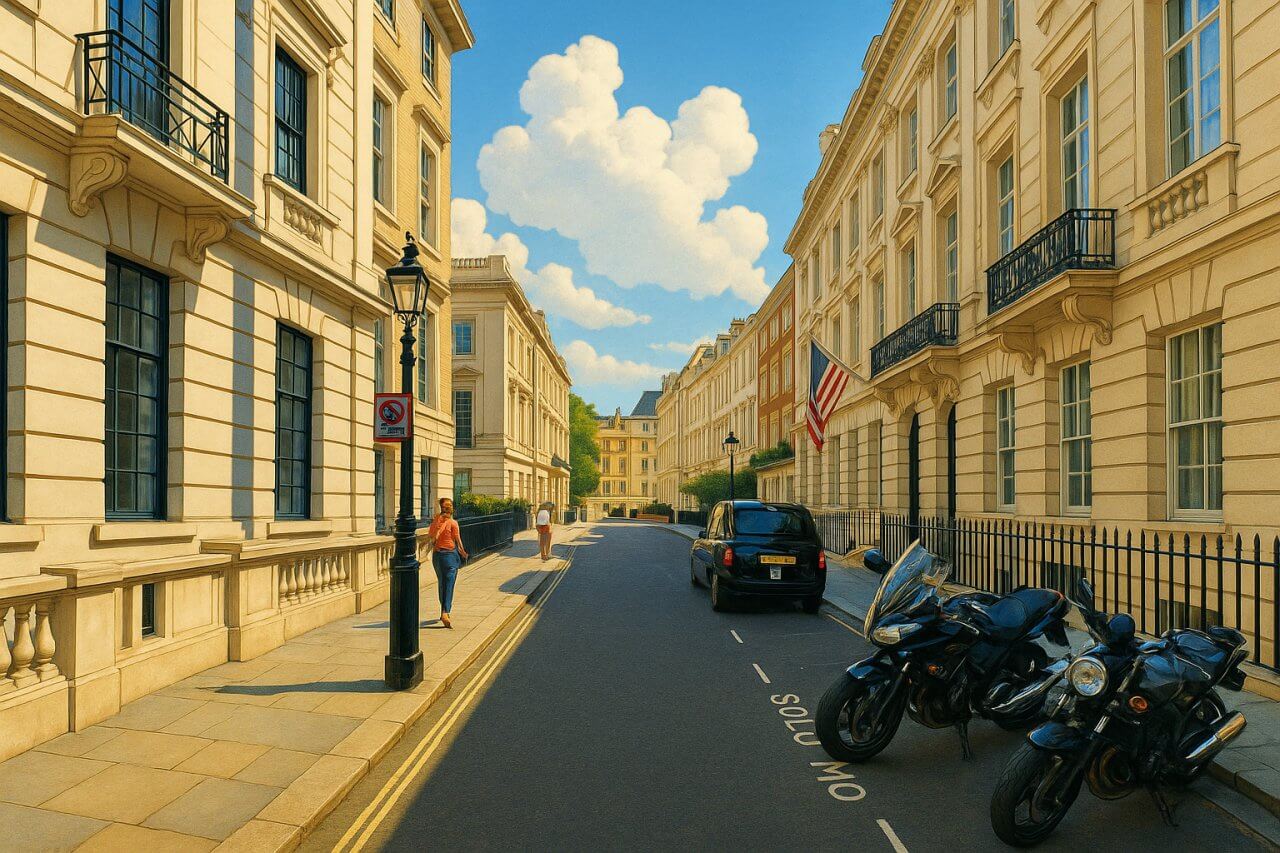
Suffolk Street, London
Suffolk Street is a short yet historically significant road nestled in the heart of central London, near Trafalgar Square. It runs from Pall Mall East at its southern end and terminates at a cul-de-sac just north of Suffolk Place. The street has a quiet character despite its central location, and is lined with a blend of office buildings, cultural institutions, and historic architecture. This hidden gem is steeped in history and offers convenient access to many of London’s most famous sights.
Overview and Layout
Suffolk Street measures approximately 108 metres (354 feet) in length. It forms a straight stretch that begins at Pall Mall East and ends at a quiet cul-de-sac. Roughly halfway along its course, it is intersected by Suffolk Place, which forms a T-junction. The street operates with one-way southbound traffic, allowing vehicles to enter from the northern cul-de-sac end and exit onto Pall Mall East. Pavements on both sides are generous, making it pedestrian-friendly.
Origin of the Name and Pronunciation
The street derives its name from Suffolk House, a grand Tudor mansion once located in the vicinity. The house belonged to Charles Brandon, Duke of Suffolk, a favourite of King Henry VIII. After the mansion was demolished in the 17th century, the name was retained in the area and applied to various new roads and developments, including Suffolk Street.
The name is pronounced "SUF-uhk", with the “l” and second “o” being silent. In the International Phonetic Alphabet (IPA), it is rendered as /ˈsʌfək/. 
Historical Background
Suffolk Street was laid out during the early 18th century, a time of rapid urban development in Westminster following the restoration of the monarchy and the rebuilding of London after the Great Fire. The land, once part of the gardens and grounds of Suffolk House, was subdivided and developed for residential and commercial use.
Over time, Suffolk Street transitioned into a primarily office-based and institutional environment. One of the most notable buildings along the street is the Royal Institute of Oil Painters, part of the Federation of British Artists, housed in the Mall Galleries building that backs onto the street.
Character of the Road
Suffolk Street maintains a low-key atmosphere, especially in contrast to the bustling avenues nearby. The street has a formal and institutional look, dominated by neoclassical façades and Georgian-style architecture. Many buildings along Suffolk Street host professional offices, galleries, and cultural organisations, contributing to a refined and academic air.
Nearby Sights and Attractions
Suffolk Street is extremely well positioned for visitors who wish to explore central London on foot. Within a short walking distance, one can find:
- Trafalgar Square – London's famous public square, home to Nelson’s Column and the Fourth Plinth.
- The National Gallery – Just around the corner, this world-renowned art museum holds masterpieces by artists such as Van Gogh, Monet, and Turner.
- The Mall – A ceremonial route leading to Buckingham Palace, lined with trees and Union Flags.
- St James’s Park – One of London's royal parks, offering scenic views, lakes, and waterfowl.
Property and Real Estate
As of May 2025, property on Suffolk Street is predominantly commercial, with limited residential availability. Where residential or mixed-use properties are found, values are high due to the prestigious location. A rare one-bedroom flat (circa 600 sq ft / 55 sq m) in the area may cost upwards of £1.2 million, while larger multi-storey premises used as live-work spaces can command £5 million or more, depending on amenities and condition.
These figures are well above the average property price in Greater London, where similar-sized flats cost around £500,000 in less central areas. Demand for real estate in this part of Westminster remains strong due to its proximity to government buildings, embassies, and iconic landmarks.
Public Transport Access
Nearest London Underground Stations
- Charing Cross Station (Bakerloo and Northern lines) – approx. 4 minutes’ walk.
- Piccadilly Circus Station (Piccadilly and Bakerloo lines) – approx. 7 minutes’ walk.
- Leicester Square Station (Northern and Piccadilly lines) – approx. 8 minutes’ walk.
Nearby Bus Stops
The closest bus stops are located on Pall Mall East and Charing Cross Road. Buses serving these stops include:
- Bus 6 – Towards Aldwych or Willesden
- Bus 9 – Towards Hammersmith or Aldwych
- Bus 15 – Towards Blackwall or Charing Cross
- Bus 23 – Towards Westbourne Park or Aldwych
Fun Fact
Though lesser-known, Suffolk Street was once part of a fashionable quarter during the Regency and early Victorian periods. Writers, artists, and minor aristocrats frequented the surrounding area. A local myth—unverified but entertaining—claims that a young Charles Dickens briefly lodged near Suffolk Street while working as a parliamentary reporter in the 1830s.
Quick Facts
- Location: Trafalgar Square area, City of Westminster
- Length: Approx. 200 metres (656 feet)
- Traffic Flow: One-way, southbound
- Historical Origin: Early 18th century, named after Suffolk House
- Pronunciation: “SUF-uhk” /ˈsʌfək/
- Nearby Sights: National Gallery, Trafalgar Square, The Mall
- Property Prices (2025): ~£1.2M+ for flats (600 sq ft / 55 sq m)
- Underground Stations: Charing Cross, Piccadilly Circus, Leicester Square
- Bus Routes: 6, 9, 15, 23
- Fun Fact: Alleged early lodging site of Charles Dickens
Map of Suffolk Street, London

Painting of Suffolk Street, London (View image in full size)